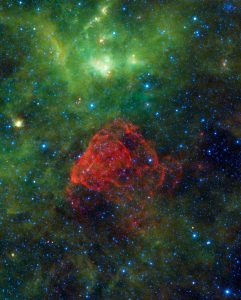Un’Antica Supernova
Circa 3700 anni fa gli abitanti della Terra potrebbero avere visto una nuova stella brillare in cielo. Quando si è affievolita ed è scomparsa dalla vista, probabilmente è stata dimenticata, finché i moderni astronomi non hanno trovato i suoi resti, chiamati Puppis A.
Visibile in questa splendida immagine del telescopio WISE come una nube polverosa rossa, Puppis A è il residuo di un’esplosione di supernova.
Si è formata quando una stella massiccia ha terminato la sua vita con una detonazione estremamente brillante e potente. Le onde d’urto in espansione derivanti da quell’esplosione riscaldano le nubi di gas e polvere che circondano la supernova, facendole brillare.
Parte del gas e della polvere colorati in verde in questa immagine deriva da un’altra antica supernova, il resto di supernova delle Vele. Questa esplosione è avvenuta circa 12.000 anni fa ed è stata quattro volte più vicina a noi di Puppis A.
Blu e ciano rappresentano la luce a infrarossi a lunghezza d’onda di 3,4 e 4,6 micron, principalmente proveniente dalle stelle. Verde e rosso rappresentano la luce a 12 e 22 micron, emessa soprattutto dalla calda polvere.
[ Barbara Bubbi ]
http://wise.ssl.berkeley.edu/gallery_Puppis_A.html
Credit NASA/JPL-Caltech/WISE Team

Lascia un commento